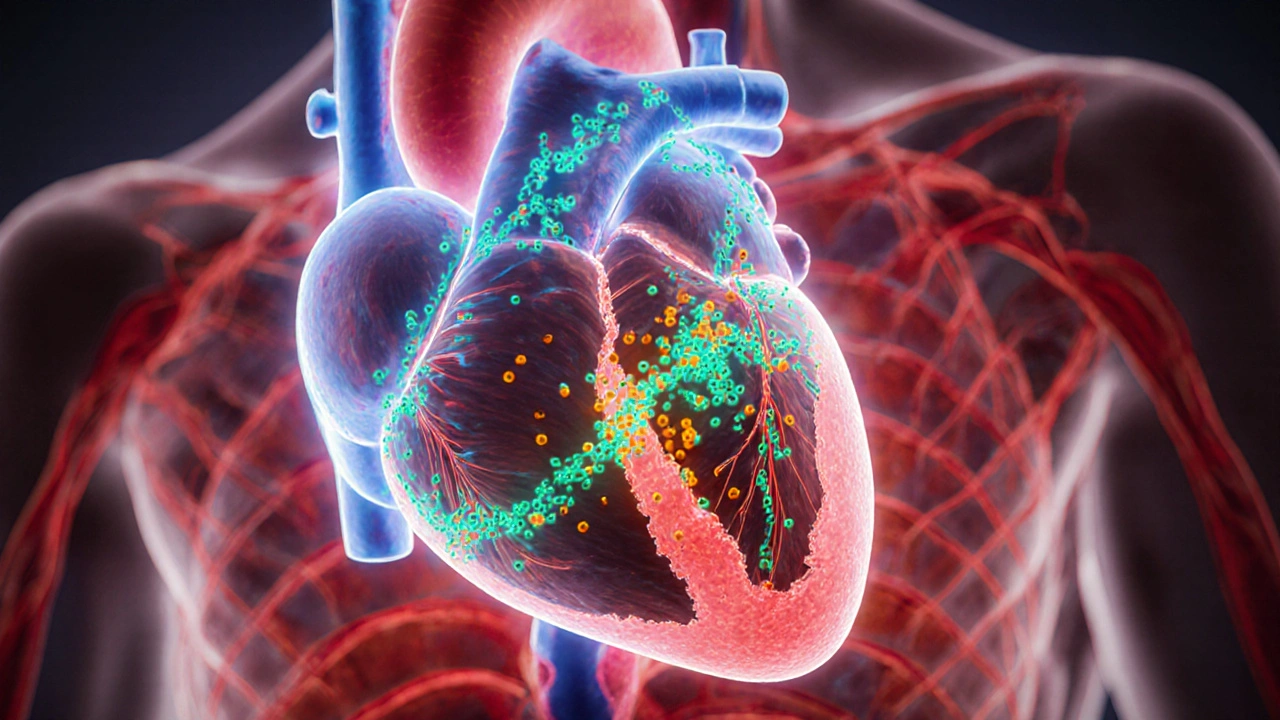Folate & Cardiovascular Risk Calculator
This tool estimates your cardiovascular risk based on folate and homocysteine levels. Enter your values below to see your risk level and recommendations.
When you hear that a vitamin shortfall can mess with your heart, it may sound like a stretch. In reality, folate deficiency is one of the most underrated risk factors for heart disease, stroke, and high blood pressure. This article unpacks why low folate levels matter, how they raise the danger of cardiovascular problems, and what you can do today to protect your ticker.
Key Takeaways
- Folate (vitamin B9) helps convert homocysteine, a harmful amino acid, into harmless compounds.
- Elevated homocysteine is linked to atherosclerosis, blood clots, and higher stroke risk.
- Common causes of folate deficiency include poor diet, certain medications, and genetic variants.
- Blood tests measuring serum folate and plasma homocysteine are the most reliable diagnostics.
- Boosting folate through leafy greens, fortified foods, or supplements can lower homocysteine by 20‑30% and improve heart health.
What Is Folate and Why Does It Matter?
Folate is the natural form of vitamin B9 found in foods. It plays a critical role in DNA synthesis, cell division, and the methylation cycle-a chemical pathway that regulates gene expression and detoxifies harmful substances. The synthetic counterpart, folic acid, is added to fortified grains and supplements because it’s more stable and bioavailable.
When folate levels drop, the methylation cycle stalls. One of the most noticeable consequences is a spike in homocysteine, an amino acid that the body normally recycles into methionine or cysteine. Without enough folate (or its co‑factors vitamin B12 and B6), homocysteine builds up in the bloodstream, turning into a vascular toxin.
How Elevated Homocysteine Harms Your Heart
Research from the American Heart Association (2023) shows that each 5µmol/L increase in plasma homocysteine raises coronary artery disease risk by roughly 20%. The mechanisms are threefold:
- Endothelial dysfunction: Homocysteine damages the inner lining of blood vessels, reducing nitric oxide production and impairing vessel dilation.
- Oxidative stress: It generates free radicals that oxidize low‑density lipoprotein (LDL), accelerating plaque formation.
- Pro‑coagulant effect: High homocysteine promotes clotting factor activation, increasing the chance of thrombosis and stroke.
These pathways directly feed into atherosclerosis, the thickening and hardening of arterial walls that underlies most heart attacks and ischemic strokes.
Who Is at Risk for Folate Deficiency?
While anyone can develop low folate levels, certain groups face higher odds:
- People with limited fruit and vegetable intake: Diets heavy on processed foods often lack natural folate.
- Pregnant or lactating women: Folate demand rises dramatically to support fetal growth.
- Individuals on antiepileptic drugs (e.g., phenytoin, carbamazepine): These medications accelerate folate metabolism.
- Heavy alcohol consumers: Alcohol interferes with folate absorption in the small intestine.
- Those with the MTHFR gene variant: This common polymorphism reduces the body’s ability to convert folic acid into its active form.
Recognizing these risk factors helps clinicians decide when to screen for folate deficiency, especially in patients with unexplained hypertension or a family history of early‑onset heart disease.

Diagnosing Folate Deficiency and Elevated Homocysteine
The gold standard blood work includes two parameters:
- Serum folate (ng/mL): Values below 3ng/mL typically indicate deficiency.
- Plasma homocysteine (µmol/L): Levels above 15µmol/L are considered elevated.
Both tests are inexpensive and can be ordered together. For patients on folic acid supplementation, measuring red‑cell folate provides a longer‑term view of intracellular stores.
Boosting Folate Intake: Food, Fortification, and Supplements
Meeting the Recommended Dietary Allowance (RDA) of 400µg dietary folate equivalents (DFE) for adults is easier than you think. Below is a quick reference:
| Source | Folate Content (µg DFE per serving) | Typical Portion Size | Notes |
|---|---|---|---|
| Spinach (cooked) | 263 | ½ cup | Rich in vitamin K and iron |
| Lentils (cooked) | 180 | ½ cup | High protein, low fat |
| Fortified breakfast cereal | 140 | 1 cup | Often fortified with vitamin B12 |
| Folic acid supplement | 400‑800 | 1 tablet | Rapidly raises serum folate |
For most adults, a daily multivitamin containing 400µg of folic acid suffices. People with the MTHFR variant may benefit from 5‑methyl‑tetrahydrofolate (5‑MTHF), the bio‑active form, as it bypasses the enzymatic block.
When increasing folate through diet, aim for at least five servings of leafy greens, legumes, or fortified grains each day. Pairing these foods with vitaminC‑rich produce (like citrus) enhances absorption.
How Folate Improves Cardiovascular Outcomes
Multiple randomized trials have examined the impact of folic acid supplementation on heart health. The most cited meta‑analysis (2019) pooled data from 12 studies involving over 30,000 participants. Key findings:
- Homocysteine levels dropped by an average of 22%.
- Incidence of major cardiovascular events (heart attack, stroke, or cardiovascular death) fell by 10% in the supplement group.
- Benefit was most pronounced in participants with baseline homocysteine >15µmol/L.
While folic acid is not a silver bullet, correcting a deficiency removes a modifiable risk factor that otherwise fuels plaque buildup and clot formation.
Practical Steps to Protect Your Heart
- Get screened: Ask your doctor for a serum folate and homocysteine test, especially if you have hypertension, a family history of early heart disease, or take medications that interfere with folate metabolism.
- Eat the rainbow: Include at least one folate‑rich food at each meal-spinach salads, lentil soups, or fortified breads.
- Consider supplementation: If dietary changes are hard, a 400µg folic acid tablet daily is safe for most adults. Talk to a healthcare professional before exceeding 1mg.
- Address lifestyle factors: Limit alcohol, quit smoking, and manage stress-these all improve folate absorption and lower homocysteine.
- Monitor progress: Repeat blood tests after 3‑6 months to confirm that folate levels have risen and homocysteine has fallen.
Integrating these steps into your routine can shave years off your cardiovascular risk profile.
Frequently Asked Questions
Can I get too much folate?
Excessive folic acid (above 1mg daily) may mask a vitaminB12 deficiency, leading to neurological damage. Stick to the recommended 400‑800µg unless a doctor advises otherwise.
Is folate the same as folic acid?
Folate is the naturally occurring form found in foods. Folic acid is the synthetic version used in supplements and fortified foods; it’s more stable but requires conversion in the body.
How fast does supplementation lower homocysteine?
Studies show a measurable drop within 4‑6 weeks of taking 400‑800µg folic acid daily, with maximum reduction around 3 months.
Are there any foods that inhibit folate absorption?
Large amounts of alcohol and excessive intake of certain raw cruciferous vegetables (like raw kale) can interfere with folate absorption. Cooking improves bioavailability.
Should I take a multivitamin or a dedicated folic acid supplement?
If you already take a reputable multivitamin that includes 400µg folic acid, that usually suffices. If you have a documented deficiency or a high‑risk gene variant, a targeted 5‑MTHF supplement may be more effective.


Folate deficiency is a silent troublemaker that can quietly shift the balance of cardiovascular health without obvious warning signs. When serum folate drops below the threshold, the methylation cycle stalls and homocysteine begins to accumulate, acting like a corrosive agent on blood vessel walls. This buildup damages the endothelium, reduces nitric oxide availability, and creates a fertile ground for atherosclerotic plaques. Over time the arterial walls thicken, making them less compliant and more prone to rupture during stress events. Elevated homocysteine also fuels oxidative stress, turning LDL cholesterol into a more harmful form that sticks to the vessel lining. Moreover, the pro‑coagulant effect of high homocysteine levels can trigger clot formation, increasing the risk of heart attacks and strokes. The synergy of these mechanisms means that a simple nutrient shortfall can translate into a cascade of vascular damage. Clinical trials have consistently shown that correcting folate deficiency can lower homocysteine by roughly 20‑30 percent, which in turn modestly reduces cardiovascular events. It is therefore prudent for clinicians to screen patients with unexplained hypertension, premature heart disease in the family, or those on medications that interfere with folate metabolism. Dietary sources such as spinach, lentils, and fortified cereals provide natural folate, but the bioavailability can vary based on preparation methods. For individuals with the MTHFR polymorphism, the active form 5‑MTHF bypasses the enzymatic bottleneck and may be more effective. Supplementation with 400‑800 µg of folic acid daily is generally safe for most adults, though exceeding 1 mg without medical supervision can mask vitamin‑B12 deficiency. Regular monitoring of serum folate and plasma homocysteine every three to six months helps ensure that therapeutic goals are met. Lifestyle factors such as limiting alcohol intake, quitting smoking, and managing stress further support folate absorption and cardiovascular health. In summary, addressing folate deficiency is an inexpensive, evidence‑based strategy to reduce a modifiable risk factor for heart disease.